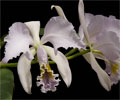|
|
|
|
|
| |
Established Seedlings of
Cattleya mossiae var. coerulea 'MC5888' × self |
|
| |
|
|
| |
| Number: |
TN8306 |
| Name: |
Cattleya mossiae var. coerulea 'MC5888' × self
|
| Type: |
self (What's that?) |
|
Seed Donor: |
Troy C. Meyers
|
|
Click to Enlarge

Pod Parent Flower |
|
|
|
| |
Comments: Parent plant: One of the offspring from our TN2504 effort of 2002.
For additional origin/habitat information supplied courtesy of
Charles and Margaret Baker, see further below, near the bottom of this page.
|
Temperatures we attempt to use in the lab & greenhouse:
| For Infraspecies: |
|
Spring, Summer, Autumn, Winter: days average 77°F, nights 60°F; best fit is Cool-Intermediate 75-58°F
(Source:
Baker's Web OSC) |
| For Species: |
|
Spring, Summer, Autumn: days average 77°F, nights 60°F; best fit is Cool-Intermediate 75-58°F
(Source:
Baker's Web OSC) |
| For Species: |
|
Winter: days average 75°F, nights 55°F; best fit is Cool-Intermediate 75-58°F
(Source:
Baker's Web OSC) |
| For Genus: |
|
Spring, Summer, Autumn, Winter: days average 83°F, nights 60°F; best fit is Intermediate 83-60°F
(
) |
|
About the name...
| Etymology of |
Cattleya |
|
Named in honor of William Cattley, English horticulturist in the 19th century.
(Source:
Pridgeon 1992) |
| Etymology of |
coerulea |
|
From Latin "coeruleus" sky-blue.
(Source:
Mayr & Schmucker 1998) |
| Etymology of |
mossiae |
|
Named for Mrs. Moss, English orchid enthusiast, during the 19th
(Source:
Mayr & Schmucker 1998) |
| Pronunciation of |
Cattleya |
|
KAT-lee-ya
(Sources:
Pridgeon 1992, Hawkes 1978) |
| Pronunciation of |
coerulea |
|
see-ROO-lee-ah
(Source:
Hawkes 1978) |
| Pronunciation of |
mossiae |
|
MOSS-ee-eye
(Source:
Hawkes 1978) |
|
If you would like to direct someone to this web page, please copy and paste this URL into your email:
http://troymeyers.com/d?128306
|
ESTABLISHED SEEDLINGS
of these are not currently available, but we have some maturing in the greenhouse and expect to offer them in the future.
There are 2 items with
1 to 16 plants per
item
(1 is a compot) that will be considered for sale later.
Click here to see if we have flasks available.
|
|
|
| |
The origin/habitat information below is supplied courtesy of Charles and Margaret Baker
The following information is based on the name of the plant provided by the donor, and assumes that the name is correct. If the plant has been misidentified, then the following information may not be correct.
This text is copyrighted by the Bakers and may not be reproduced without permission.
ORIGIN/HABITAT: Venezuela. Plants grow at 2950-4900 ft. (900-1500 m) in
the intermediate to cooler parts of the coastal mountains westward from
the State of Anzoategui to the extreme eastern part of the Andes in the
State of Lara. It reportedly grows in patches of cloud forest on the
north-facing slopes, but in recent years, according to Dunsterville, it
has been found primarily on the south-facing slopes where the forests that
still exist are not true cloud forest.
More about this information and the Bakers...
|
|
|
| |
|
|
|